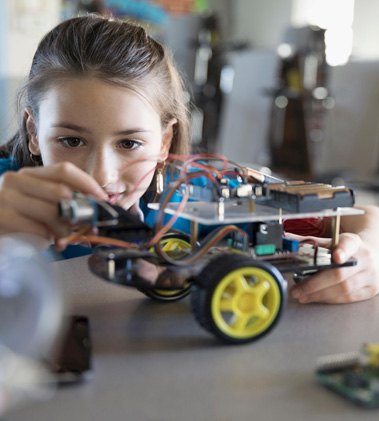At COmEd, Students Enjoy a Wealth of Summer STEM Opportunities
Icebox Derby Has Girls Racing Toward STEM; High Schoolers Learn Tools of the Trade
In the United States, STEM jobs are some of the highest paying and most competitive, not to mention some of the most exciting. But women fill just 25 percent of these positions.
ComEd would like to change that, and company leaders think they’ve found a good way to get started: an annual Icebox Derby. It’s just one of several ways the company engages high school students during the summer months (both female and male), encouraging them to learn more about the industry and the opportunities available to them at ComEd.
Icebox Derby
For two weeks each summer, 30 girls ages 13-18 come from all over northern Illinois to learn how to build and race derby cars made from recycled refrigerators. They spend four days building them and one day competing on the track, tackling STEM challenges between laps. At the end, each one walks away with an ipad tablet and a $1,500 scholarship – along with connections at ComEd that may turn into internships and potential career opportunities down the road.
“ComEd feels that if you want to make a change, you’ve got to start within your own community,” said ComEd Principal Program Manager Josey Nieto, who is a lead mentor for the Icebox Derby program.
Not only is the derby an opportunity to get girls excited about STEM and its potential career paths, it’s also a way for women at ComEd to inspire the next generation of young women to follow in their footsteps, said Nieto.
“Beyond our commitment to developing the workforce of the future, it’s a way for our mentors to give back. Our women mentors love this program as much as the girls do,” she said.
ComEd uses female employees as mentors to teach the girls all they need to know to build and race the derby cars. Along the way the girls learn about what the women do at ComEd and have a chance to imagine themselves in those careers.
“We show them there are other women in STEM,” said Nieto. “We’re all about encouraging them and showing them that they can do it, too.”
The annual summer derby program is highly competitive, with several hundred girls applying for just 30 openings each year. The applications, in which girls answer questions about their interest in STEM and why they want to participate, are judged by a third party, said Nieto. Successful applicants attend free of charge and are invited back each year to cheer for the next group of derby racers.
Derby racers learn a lot of STEM concepts during the four “build” days, Nieto said. For example, they’re taught how to wire a circuit to connect a car horn and lights, count gears and understand gear ratios and hook up a car battery. On Race day, they practice driving in the morning and must complete timed STEM challenges for their team before they can drive their laps on the track. Winning teams earn bragging rights and the chance to parade the trophy around their home school, said Nieto, “like the Stanley cup.”
Tools of the Trade
After the Derby, many of the girls stay in touch with their mentors, who invite them to apply for internships and to take part in other ComEd STEM programs for students, such as After School Matters, ComEd Tools of the Trade, a seven-week introduction to STEM, the energy industry and the skilled trades held during the summer months at the ComEd Chicago Training Center.
ComEd Associate Project Manager Hannah McGoldrick said the program targets 16-18-year-old Chicagoland students. ComEd runs the program in partnership with After School Matters, a nonprofit organization that identifies and recruits inner-city students, who are paid a stipend of several hundred dollars for participating. Each partner provides an instructor to co-teach the classes, which run from 10 a.m. to 3 p.m., Monday-Thursday.
This past summer, the program served 12 students, including 10 boys and two girls. The program covered an overview of the energy industry, including how energy is delivered from the power station to your home; renewable energy sources, such as solar, wind and hydropower; safety issues; and an introduction to the skilled trades, including hands-on projects using power tools, such as making a giant Jenga game and two dog houses that will be sold to benefit a local animal shelter.
Students are also given instruction in math and reading comprehension, as preparation for pre-employment tests such as the CAST, said McGoldrick. “We focus on practice questions and try to enhance their math skills,” she said.
At the end of the program, the students are asked to deliver presentations to ComEd leadership with a partner. This gives the students the opportunity to showcase what they learned throughout the program, their leadership skills and their elevator pitches.
The program, now in its third year, has been so successful the company has inspired many students to consider ComEd as a future career, McGoldrick said. As high school graduates, they would be eligible to work as customer service representatives or field employees. They also hope to keep in touch with those who are now pursuing college degrees, who would make good candidates for entry-level positions down the road.
“It is a great benefit to ComEd to have students who are eager to work in the energy industry and have been exposed to what we do,” she said.
